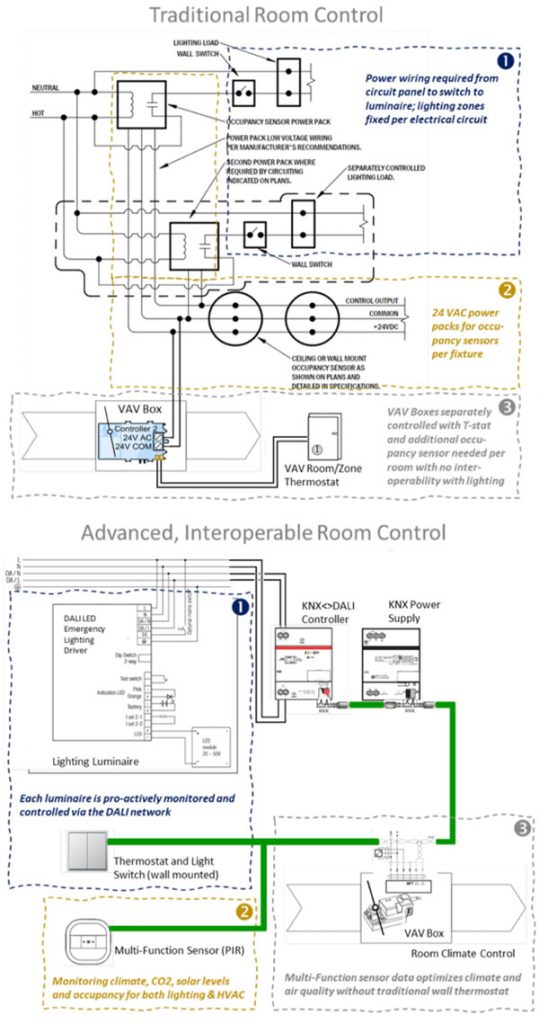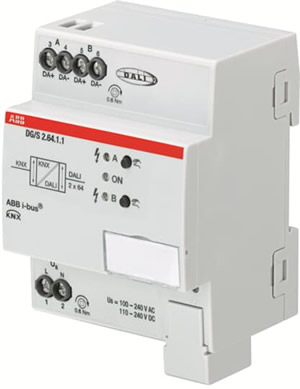
By Philip R. Juneau, ATC.
You may think the title bold, but based on all of the successful and sustainable installations worldwide, I’m quite comfortable and proud to state this. I must admit, for many years, I was unaware of the KNX technology being in the HVAC (i.e., BMS) controls industry, which operates mainly in a BACnet environment. However, after being exposed to the KNX protocol’s functionality, I quickly realised its true power as a robust, reliable room/occupant-level controls protocol.
In this month’s article, I want to compare what is being traditionally done today and what the future of controls could look like here in the USA. Below is an illustration of traditional vs. KNX room-level control.

Zoning and detailed monitoring per luminaire
In traditional lighting systems, 120/277V power wiring is required from the circuit panel to the switch and then to the luminaire, making the lighting zones fixed for each installed electrical circuit. Hence, future renovations will require existing electrical circuits and associated switches and sensors to be modified. There is also zero transparency regarding the lighting fixture and overall energy allocation.
With a KNX-DALI system, no power wiring is required to the low-voltage intelligent switches/sensors, saving considerable material and installation labour costs. Each luminaire can be proactively monitored and controlled by the DALI network’s ability to provide key operational data for each luminaire, as each LED driver is a node on the DALI communication network. By integrating DALI into the KNX protocol via a KNX-DALI controller, we integrate the DALI lighting data together with the KNX building system data to take advantage of the KNX protocol’s backbone functionality. This then allows us to, for example, use diagnostic tools to determine the luminaire operational status such as power, LED module/strip, LED driver status, light output, etc).
In other words, the KNX-DALI system revolutionises lighting maintenance with a platform that provides a proactive, highly-transparent monitoring and controlling regime.

Low-voltage sensors on a robust network
Traditional motion/occupancy sensors require 24V power packs for each sensor, which involves significant installation labour and material costs for conduits, wires, etc, on top of its own substantial cost. Also, these motion sensors are only measuring occupant presence and are missing other key room characteristics such as temperature, humidity, CO2, solar gain/loss, LED lumen output, and LED driver amperage.
With the KNX-DALI system, all of these values come under one umbrella. We can measure presence, climate and solar gain/loss from the ceiling-mounted KNX multi-function sensor; temperature, humidity and CO2 from the wall-mounted KNX room unit; and LED lumen output, amperage, etc from the DALI LED drive.
By using low-voltage wiring and communication with these room sensors on both lighting (including daylight) and HVAC, you can eliminate considerable first installation costs as well as provide a future-proof building control system using the open protocols of KNX and DALI.

Complete room control
With the traditional HVAC system, the control operation is irrespective of the lighting or other adjacent systems. This is due to the different trades in building construction industry being kept separate, which is not always conducive to a holistic and integrated building operational environment. In these cases, the room ventilation VAV (Variable Air Volume) boxes are controlled separately with a thermostat and an additional (to the lighting) occupancy sensor. This is redundant from a control perspective and, quite frankly, a myopic view resulting in wasted money and time.
With the KNX-DALI system, room climate is truly interoperable since the lighting and HVAC components are based on the same standard! It’s really that simple. Why have separate systems when you can follow a longstanding, industry-leading standard for room occupancy? For the other central automation and data exchange, BACnet is still the preferred method and is very interoperable with KNX since both are ASHRAE standards.
Conclusion
With the KNX and DALI combination, I hope that I’ve shown that mastering room-level control cannot be more streamlined and straightforward. The mechanical and electrical trades can be united on the occupant level, where the greatest efficiencies are to be achieved. In addition, you will not be beholden to any one supplier or integrator, as there so many devices, tools and services available from multiple providers, making it a future-proof choice for your building controls.
Philip R. Juneau is the Chief Commercial Officer for Automated Technology Company (ATC), and Vice President of the KNX USA National Group. ATC’s mission is to transform today’s buildings into tomorrow’s net-zero infrastructure by ensuring the highest levels of safety, comfort and efficiency for the overall well-being of its occupants and the overall environment.
Philip R. Juneau is the Chief Commercial Officer for Automated Technology Company (ATC), and Vice President of the KNX USA National Group. ATC’s mission is to transform today’s buildings into tomorrow’s net-zero infrastructure by ensuring the highest levels of safety, comfort and efficiency for the overall well-being of its occupants and the overall environment.











